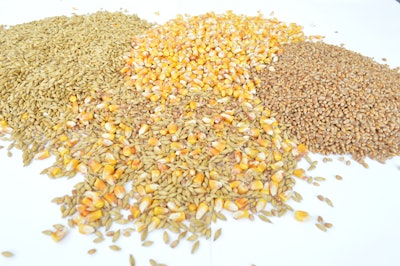
On Friday, USDA released its World Agricultural Supply and Demand Estimates.
WHEAT: The outlook for 2019/20 U.S. wheat is for stable supplies, increased feed and residual use, and lower stocks. Feed and residual use is raised 10 million bushels on lower-than-expected second-quarter stocks reported in today’s NASS Grain Stocks report. Seed use is down 1 million bushels reflecting 2020/21 wheat planted area released today in the NASS Winter Wheat and Canola Seedings report. Ending stocks are now projected at 965 million bushels, down 9 million from the previous report. The season-average farm price is unchanged at $4.55 per bushel.
Foreign production for the 2019/20 market year is dropped 1.0 million tons led by a 1.0- million-ton reduction for Russia on updated government production data, and a 0.5- million-ton decrease for Australia reflecting the severe drought conditions in parts of the country. Partly offsetting is a 0.5-million-ton increase for the European Union. Foreign consumption is raised fractionally, and global exports are raised 1.3 million tons. The export increase is led by a 2.0-million-ton increase for the EU on improved price competitiveness and a 0.5-million-ton increase for Ukraine on pace to date. Partly offsetting is a 1.0-million-ton decrease for Russia reflecting lower supplies and higher relative prices. With foreign supplies falling and total use increasing, foreign ending stocks are lowered 1.2 million tons to 261.8 million.
COARSE GRAINS: This month’s 2019/20 U.S. corn outlook is for greater beginning stocks, slightly higher production, reduced food, seed, and industrial use (FSI), larger feed and residual use, lower exports, and smaller ending stocks. Beginning stocks are raised 107 million bushels reflecting upward revisions to both on-farm and off-farm stocks as of September 1 as reported in Grain Stocks. Corn production is estimated at 13.692 billion bushels, up 31 million as a higher yield more than offsets a reduction in harvested area.
Total corn use is up 155 million bushels to 14.070 billion. Exports are reduced 75 million bushels to 1.775 billion, reflecting the slow pace of shipments through December, and the lowest level of outstanding sales as of early January since the 2012/13 marketing year. FSI use is lowered 20 million bushels, with lower projected corn used for starch, glucose and dextrose, and high fructose corn syrup. Feed and residual use is raised 250 million bushels to 5.525 billion, based on indicated disappearance during the SeptemberNovember quarter and the 2018/19 marketing year as reflected by the Grain Stocks report. With use rising more than supply, 2019/20 corn stocks are reduced 18 million bushels. The season-average corn price received by producers is unchanged at $3.85 per bushel.
Global coarse grain production for 2019/20 is forecast marginally higher to 1,401.8 million tons. This month’s foreign coarse grain outlook is for slightly lower production and consumption, and reduced stocks. Foreign corn production is forecast higher with increases for Bangladesh, Russia, and the EU. Other major coarse grain production changes include larger barley production for the EU, with reductions for China and Australia.
Major global coarse grain trade changes for 2019/20 include increased corn exports for Ukraine and the EU. For 2018/19, Brazil’s exports for the marketing year beginning in March 2019 are raised based on observed shipments to date. Barley exports for 2019/20 are raised for the EU, Argentina, and Ukraine, with a partly offsetting reduction for Australia. Barley imports are raised for Turkey and China. China’s corn feed and residual use is raised for both 2018/19 and 2019/20 based on lower barley feeding. Foreign corn ending stocks are lower, mostly reflecting reductions for China and Brazil. Global corn stocks, at 297.8 million tons, are down 2.8 million.
OILSEEDS: U.S. oilseed production for 2019/20 is estimated at 107.4 million tons, down 0.2 million from last month. Smaller canola, sunflowerseed, peanut, and cottonseed crops are partly offset by a larger soybean crop. Soybean production is estimated at 3.56 billion bushels, up 8 million on a higher yield. Harvested area is estimated at 75.0 million acres, down 0.6 million from the previous forecast, with the largest reductions for North Dakota and South Dakota.
Yield is estimated at 47.4 bushels per acre, up 0.5 bushels led by increases for Illinois and Indiana. Soybean supplies are relatively unchanged as lower beginning stocks and imports offset higher production. With crush and export forecasts unchanged, ending stocks are projected at 475 million bushels.
The U.S. season-average soybean price for 2019/20 is forecast at $9/bushel, up 15 cents in part reflecting stronger soybean oil prices. The soybean oil price forecast is raised 3 cents to 34.0 cents per pound. The soybean meal price forecast is reduced $5.00 to $305.00 per short ton.
Foreign oilseed 2019/20 production is up 0.2 million tons to 467.2 million, with higher sunflowerseed production partly offset by lower cottonseed, rapeseed, and palm kernel. Sunflowerseed production is increased for Russia on higher yields. Palm kernel and palm oil production are lowered for Malaysia due to dry weather conditions over the past year. Lower global vegetable oil production paired with increasing demand results in a 9 percent year-over-year decline in vegetable oil stocks. Other notable oilseed changes include a 0.5-million-ton increase to Chinese soybean crush due to a higher-than expected pace to date.
To review the entire WASDE report, click here.

















